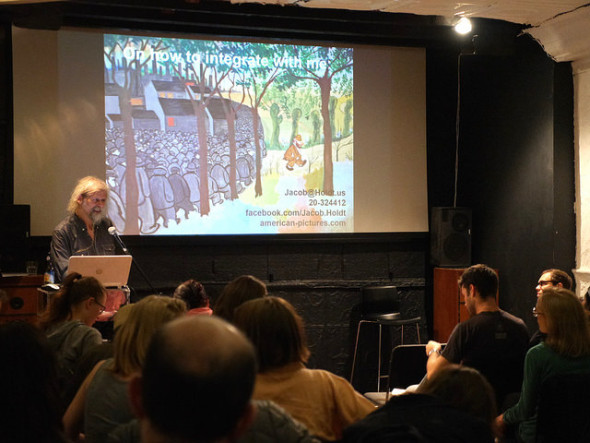
“This is a talk that can be sometimes 6 hours long. I think I will shorten several parts of it and go straight into talking about areas and talk about people that we really have difficulties integrating with – and haven’t seen anything good in – the Ku Klux Klan, child molestors and stuff like that. And mass murderers, you know.” Standing in front of a full crowd on a Friday night, the long-bearded, self-announced ‘vagabond’, and photographer Jacob Holdt starts his 4-hour presentation by telling the crowd how narrow-minded and un-compassionate they are. A polite, awkward giggling from the crowd and an attentive silence falls over the room as the 68-year-old Dane takes up the rostrum in front of the screen, asking “what is racism?”, while depicting harsh pictures of suffering Americans of all sorts. Holdt does not mince his words when introducing his life-long project American Pictures Order . The life story, picture collection, travel-diary, whatever you want to call it, started in the mid-70s, when Holdt traveled through the US for the first time. Unable to stay in school because of concentration problems, and unable to serve in the army because he did not want to use a gun, he traveled to Canada in his early 20s to work on a farm. After finishing work, he wanted to go to Latin America, but on his way to South America he got stuck in the US; feeling fascinated and terrified at the same time by the things he experienced and the people he met:
“as soon as I got to the US, I fell in love with it. Already the first day I was raped by a black homosexual; on the third day I was attacked by three blacks with guns. It was something I had never experienced in Denmark – all that pain and anger. (…) I was curious to find out where all this pain and anger was coming from.”
This bold curiosity and pondering about the origin of anger and pain made him hitchhike across the US several times. He met and lived with people from the bottom of society and captured all of his experiences and meetings in photos, which he took with a small, thrifty Canon camera that his parents had sent him from Denmark. After 5 years on the road he came home with 15,000 pictures, which ended up constituting the book, American Pictures.
Throughout the four hours of the presentation, some of the most fundamental questions of human psychology were raised– where does the anger in all of these people (i.e. his subjects) come from? How do we generate all this fear? How do we (in Holdt’s words) “unlearn” our racism? How can we learn to understand and see only the goodness in people?
In answering these questions, Holdt mentions only examples from his own life: the destinies he faced and the fatal dramas he has been involved in; in one of his many examples showing both the anger and the love he believes exist in all people, he tells a very story about two African-American girls whom he met while traveling somewhere in the Midwest:
“Some friends took me to a bar, and said: “wait here. Sit here and wait for a while and we’ll find you a place to stay”. Then a short while later they came back totally upset, saying “we’ve got money for you now and a motel you can stay in”. “Motel!” I said, “I never stay in hotels”. I always stay with people! “But you are going to stay with us in a motel”. And then when we’re sitting there in the motel bed at night I saw them praying and praying and praying: “please God, please God let him not die”, in between shooting up heroin. And little by little I found out that to find money for a hotel for me they had gotten a white taxi driver to drive into a black alley to give him a blowjob, and just made enough money for this motel stay. Then one of them had said to the other: “if we also rob him, then we’ll get enough money for a shot of heroin as well. Then they had taken a big brick and crossed his skull, which they after that of course had felt very guilty about. So they kept praying to God for him Purchase Pills [the taxi driver] not to die. The next day, however, they were more upset because they overslept and therefore were too late for church, where they were supposed to sing in the church choir.”
Commenting upon his encounter of meeting these two young girls, Holdt compares the episode to biblical writings by calling it “the American version of the good Samaritan”. Criticizing the system, the media, and powerful authorities, Holdt blames external forces for being responsible for all criminality, hate and anger inherent in his subjects. Instead of judging people, their social background and environment or personality, Holdt explains that he tries to understand the actions behind all evil deeds:
“remember, it was from goodness that they ended up doing an evil thing. That is this goodness that I can always find in all my murderer friends, (…) and in all people”.
http://rovingcards.com/how-much-norvasc-can-you-take/ After 2 hours of intense lecturing, a short break allowed the concentrated audience to exhale. Holdt’s initial promise of subjecting the audience to an experiment of oppression continued without exceptions in the second half, as he went to a chapter of his book solely dedicated to his experiences of obliging the Ku Klux Klan in the South of the US. Talking about the encounter with a minority that has been condemned for decades, Holdt’s consistent message that all people are good, he tries to convince the audience at UnionDocs about the good intensions inherent in the Klan members he met; he turns around the picture by renouncing all the hate surrounding the movement, looking under the robes of the white ghosts to scrutinize the social vulnerability in the KKK people he meets. Having received an open invitation from the Klan-leader to come and live with his family, Holdt finally, after many years, decided to go down “and find out what this Ku Klux Klan was all about. (…) however, in the mean time he[the Klan-leader who had invited Holdt years before] had been sentenced 30 years in prison, so then what should I do, since he was the one who had invited me? Well, then I had to move in with his wife instead. She was now the functioning Klan-leader in America, so as you can see [showing a picture of himself and the female Klan-leader, both wearing robes with the insignia of the KKK] I had so many funny girlfriends in my life; you know, Muslim girlfriends, lesbian girlfriends; I loved the impossible you know; the forbidden you know. So I proposed to her with flowers and so on (…) and what did this woman say? Of course ‘yes’. And it is important to understand why”.
Building on his concept and emphasis of the importance of tolerance, understanding and respect, Holdt’s statement comes full circle by comparing the motives of the KKK-member with all other “oppressed” people he has been meeting on his 40-year anthropological journey:
“they have been attacked all their lives by hate and bottles and bricks; hate, hate, hate. Suddenly a guy like me shows up, saying ‘hey, shouldn’t we play together?’ – and that is all I am saying with this foolish picture [of Holdt and his Klan-wife], you know, and that is just love”.





